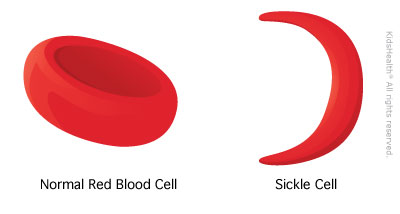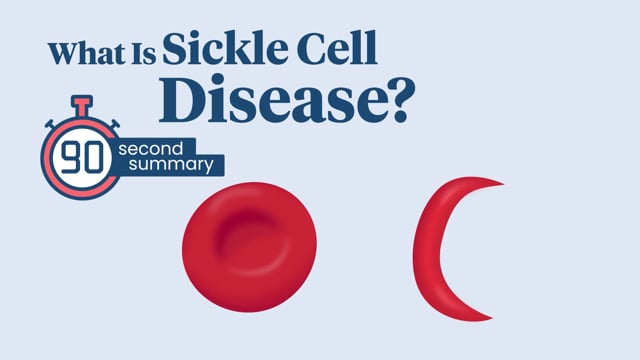Sickle Cell Disease
What Is Sickle Cell Disease?
Sickle cell disease is a group of conditions in which red blood cells are not shaped as they should be. Red blood cells normally look like round discs. But in sickle cell disease, they're shaped like sickles, or crescent moons, instead.
The sickle shaped cells cause problems because:
- They are stiff and sticky and block small blood vessels when they get stuck together. This stops blood from moving as it should, which can lead to pain and organ damage.
- They break down faster than normal red blood cells. That leads to too few red blood cells, a condition called anemia.

What Are the Signs & Symptoms of Sickle Cell Disease?
Kids who have sickle cell disease may feel pain in different parts of the body when blood vessels get clogged with sickle cells. The pain can last a few hours or several days, and it might hurt a lot or just a little. When this happens, it's called a sickle cell crisis or pain crisis ("crisis" means a time of trouble).
Nobody knows exactly when sickle cells might get stuck or which blood vessels might get clogged. Some things can lead to a sickle cell crisis, like if a person gets too cold, gets sick, has a lot of stress, or doesn't drink enough liquids. Doctors and nurses can help by giving medicine to make the pain better.
Because kids with sickle cell disease don't have enough normal red blood cells, they may get tired a lot. They also can get infections more than other kids do. They may not grow as fast as their friends. Sometimes the skin and whites of their eyes have a yellowish color, known as jaundice (say: JON-dus).
What Causes Sickle Cell Disease?
Sickle cell disease is an inherited (say: in-HAIR-uh-ted) disease. That means you can't catch it from other people like you can catch a cold or the flu. Kids are born with the disease when both parents pass along the sickle cell gene to their children.
How Is Sickle Cell Disease Treated?
Kids with sickle cell disease should get all recommended vaccinations. Most also take penicillin (say: pen-uh-SIL-in), a drug that helps prevent infections. A doctor may also prescribe a vitamin called folic acid, which helps the body make new red blood cells. Another medicine, hydroxyurea (say: hi-drok-see-yu-REE-uh), can make sickled red blood cells less sticky and less likely to cause problems.
Taking medicine does not cure sickle cell disease, but it can help keep kids who have it from getting sick. Pain medicine also helps them feel better when they have a sickle cell crisis. Kids with sickle cell disease may need to go to the hospital if they have a lot of pain or a serious infection. At the hospital, they can get liquids, antibiotics, or other medicine.
Sometimes kids with sickle cell disease need blood transfusions (say: trans-FEW-zyuns). That's a way to put healthy blood cells right into a kid's body.
In some cases, a bone marrow transplant can cure sickle cell disease. Bone marrow transplants replace the sickle cells with healthy cells from someone else. They are risky and not right for everyone, so scientists are working on finding other ways to cure sickle cell disease.
What Can a Kid Do to Stay Well?
Having sickle cell disease can be frustrating and sometimes painful. To help manage sickle cell disease:
- Take the medicines as your doctor says.
- Avoid things that can cause you to have pain, such as being very cold or very hot.
- Talk to your doctor about which activities are right for you and which you should avoid.
- Don't smoke, drink alcohol, or take drugs.
- Drink lots of liquids and get enough rest.
- Let an adult know if you don't feel well.
-

What Is Sickle Cell Disease?
Sickle cell disease causes red blood cells to be curved, or sickle shaped, instead of round. Find out what can happen and how medicine can help.


